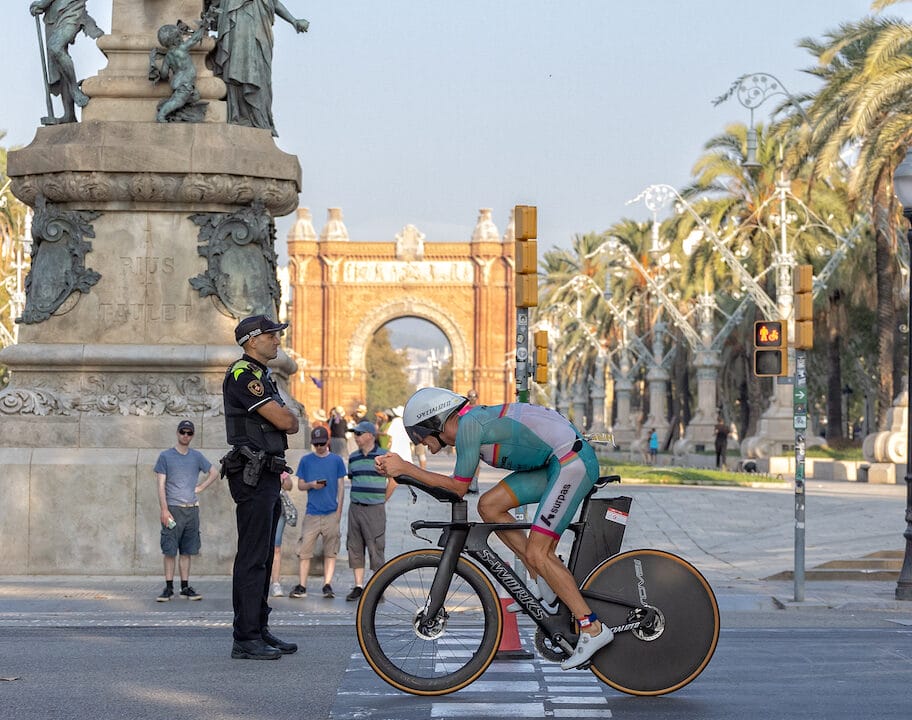As triathlon bike splits have become blisteringly quick, both PROs and amateurs alike are taking inspiration from the cycling world when it comes to optimising aerodynamics and seizing every marginal aero gain going. And that’s seen the development of some pretty aggressive aero/TT positions – think Gustav Iden in Kona last year!
But having all the aero gear and a CdA-busting bike position won’t help you that much if you can’t hold your TT position for longer than a few minutes. And it’s something that plenty of us can struggle with come race day, especially on flat courses. I spoke with former professional cyclist and time trial specialist, Alex Dowsett (who also held the hour TT record), to get his top tips on what we can do to get better at holding our TT positions – from bike set up, to training and race day.
The bike should be doing the heavy lifting
Many of us can go through countless rounds of bike fits to find the sweetspot between an aggressive aero position and a position that we can actually hold and push power. And often, we’ll operate under the assumption that we need to just get used to be uncomfortable. But that’s a bit of a myth, says Alex Dowsett.
“I’ve found that generally the better the time trialist, the more comfortable their bike is to ride. I believe there’s a common misconception among athletes that a TT bike should be uncomfortable, especially when trying to hold an aero position.”
“When I set people up on a TT or Tri bike I work on the ethos that the bike should be doing the heavy lifting of your aero position for you, not the other way round. So this really isn’t about finding a balance of aerodynamics and being able to push power, this is setting things up to optimise both simultaneously.”
If you’re really having to force your body to hold your TT position – it’s probably not the right position. The good news is, there are a few things you can do in training to help you get better at riding in an aero position.
What to do in training to improve your ability to push power in the TT position
Obviously, one of the best things you can do to get better at holding your TT position is spend plenty of time riding in it. But there are also some other specific things you can focus on in training, says Alex.
“Time in position is important. Additionally, intervals where the power is tolerable but you’re moving the cadence around to uncomfortable ends of the cadence range will also help greatly.”

“Neuromuscular work as well can be a great way of tricking your body into adapting to the position quickly. 6 second standing start, overgeared efforts with an awful lot of rest between don’t feel like you’re doing a lot, but they really work. Lastly, making sure that the posterior chain is as flexible as possible, if nothing else to avoid injury.”
When to stay aero, and when to sit up
It can be easy to get hung on ‘staying aero’ and ignoring seizing muscles to force ourselves to stay aero. But in a triathlon, this can mean you end up running like a geriatric T-Rex. Not ideal! Sometimes taking short breaks from your TT position to get some nutrition on board and have a quick stretch out can actually be more beneficial to your overall race. Alex explained how to judge when aero is everything, and when you’re not going to lose too much time if you need to break aero for a bit of respite.
“There’s a time and a place where aero is super important and where it isn’t. If for example you’re travelling at 50kph in a 20kph tailwind, the wind speed is only 30kph, however if you’re doing 30kph into a 20kph headwind then the wind speed is 50kph. In this case here aero is more important at the slow speed than the high speed.
If you’re going uphill as well it’s a great time to get out the saddle and ease the body from the aero position and going downhill at high speed time gained from high power is minimal compared with the flat and uphill so focus on aero but not on power, which is also a nice time to subtly give your body a break.”
Quick recap
So to summarise Alex Dowsett’s expert tips for getting better at holding your TT position on the bike. First up make sure your bike fit is realistic for your flexibility and range of movement. A super aggressive position will become pretty useless if you have to force your body into an unsustainably uncomfortable position to hold it. Work with your bike fitter to find a set up where you can comfortably get down on the bars.
Spend time in the TT position in training. But also add in targeted interval work, adjusting cadence and using short overgearing efforts to build strength and enhance neuromuscular recruitment. Focus on maintaining – or improving – your posterior chain mobility. That means hamstrings, glutes and hip flexors.
And finally, get to know the conditions where you can ‘get away’ with sitting up to get a short break from the TT position without too much of an aero cost. For example, on the uphills or when you’ve got a tail wind. These short breaks could help you to be able to hold your TT position when it really counts – like when you’re battling against a head wind!










